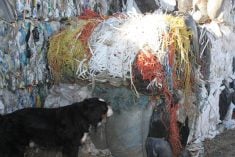Seeded prairie winter wheat acreage shot up 60 percent in fall 2006, climbing to 1.2 million acres.
Statistics Canada reported last month that total Canadian winter wheat acreage declined slightly from last year, dropping from 1.865 million acres to 1.839 million.
However, the increase on the Prairies is welcome news to those who work to provide more and better waterfowl habitat in the three provinces.
Paul Thoroughgood, regional agrologist with Ducks Unlimited Canada, called a million acres of nesting habitat an exciting success.
“The interest in seeding a million acres has been there for a few years,” he said. “We’ve been trying to get winter wheat on the radar screen.”
Read Also

Alberta looks for agricultural plastic management input
Alberta provincial government giving agriculture industry a say through survey in shaping future plastics management
Waterfowl that nest in winter wheat fields are 10 times more likely to successfully hatch their eggs than those that nest in spring-seeded fields. Conservation organizations have long worked with winter cereal growers to meet the objectives of both.
Thoroughgood said surveys have found that two-thirds of growers who got involved through the Ducks Unlimited program are still growing winter wheat five years later.
Traditionally, Manitoba has led the way as growers tried to avoid fusarium. Sawfly and midge damage can also be avoided. But the big growth in the 2007 crop will be in Saskatchewan, where seeded acreage went to 530,000 from 300,000. Manitoba farmers sowed 480,000 acres, compared to 330,000 last year, while in Alberta there are 220,000 seeded acres compared to 140,000.
Thoroughgood said some of Saskatchewan’s increased growth was seen in the northeast, where flooding prevented spring seeding. Generally warm dry fall conditions allowed farmers to seed this fall.
Farmers can calculate the forecasted winter survival of their crops thanks to soil temperature probes placed at several locations across the Prairies. The data and how to calculate survival can be found through the winter wheat production manual on the wintercereals.ca website.















